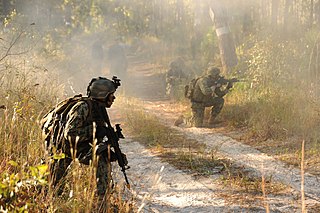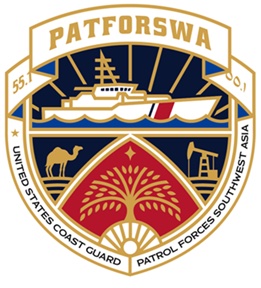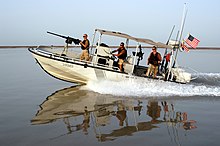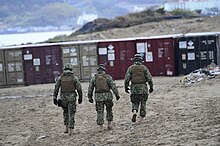The United States Armed Forces are the military forces of the United States. The armed forces consists of six service branches: the Army, Marine Corps, Navy, Air Force, Space Force, and Coast Guard. All six armed services are among the eight uniformed services of the United States.

The United States Coast Guard (USCG) is the maritime security, search and rescue, and law enforcement service branch of the United States Armed Forces and one of the country's eight uniformed services. The service is a maritime, military, multi-mission service unique among the United States military branches for having a maritime law enforcement mission with jurisdiction in both domestic and international waters and a federal regulatory agency mission as part of its duties. It is the largest coast guard in the world, rivaling the capabilities and size of most navies.

The United States Coast Guard Reserve is the reserve component of the United States Coast Guard. It is organized, trained, administered, and supplied under the direction of the Commandant of the Coast Guard through the Assistant Commandant for Reserve (CG-R).

Law Enforcement Detachments or LEDETs are specialized, deployable maritime law enforcement teams of the United States Coast Guard. First established in 1982, their primary mission is to deploy aboard U.S. and allied naval vessels to conduct and support maritime law enforcement, interdiction, or security operations. LEDETs are the operational elements of the Coast Guard’s two Tactical Law Enforcement Teams (TACLETs) which are part of the Coast Guard’s Deployable Specialized Forces (DSF). As of April 2010 there are seventeen LEDETs.
The history of the United States Coast Guard goes back to the United States Revenue Cutter Service, which was founded on 4 August 1790 as part of the Department of the Treasury. The Revenue Cutter Service and the United States Life-Saving Service were merged to become the Coast Guard per 14 U.S.C. § 1 which states: "The Coast Guard as established January 28, 1915, shall be a military service and a branch of the armed forces of the United States at all times." In 1939, the United States Lighthouse Service was merged into the Coast Guard. The Coast Guard itself was moved to the Department of Transportation in 1967, and on 1 March 2003 it became part of the Department of Homeland Security. However, under 14 U.S.C. § 3 as amended by section 211 of the Coast Guard and Maritime Transportation Act of 2006, upon the declaration of war and when Congress so directs in the declaration, or when the President directs, the Coast Guard operates as a service in the Department of the Navy.
The United States Coast Guard is the coastal defense, search and rescue, and maritime law enforcement branch of the United States Armed Forces and is one of the country's eight uniformed services. It carries out three basic roles, which are further subdivided into eleven statutory missions. The three roles are:

The EXW qualification is a warfare qualification awarded to enlisted United States Navy personnel assigned to U.S. Navy expeditionary combat units, who satisfactorily complete the required qualification course and pass a qualification board hearing. The program was approved July 31, 2006 by then-Chief of Naval Operations Adm. Michael Mullen.

The United States Marine Corps is organized within the Department of the Navy, which is led by the Secretary of the Navy (SECNAV). The most senior Marine commissioned officer is the Commandant of the Marine Corps, responsible for organizing, recruiting, training, and equipping the Marine Corps so that it is ready for operation under the command of the unified combatant commanders. The Marine Corps is organized into four principal subdivisions: Headquarters Marine Corps, the Operating Forces, the Supporting Establishment, and the Marine Forces Reserve.

The Special Missions Training Center (SMTC), also known as Joint Maritime Training Center (JMTC), is a joint United States Coast Guard, Navy, and Marine Corps training facility located on Camp Lejeune, North Carolina. SMTC's mission is to provide relevant and credible Maritime Security Training and Operational Testing and Evaluation in support of Department of Defense and Department of Homeland Security missions. SMTC comprises four main divisions: Weapons, Port Security, Engineering / Logistics, and Fast Boat.

The Navy Expeditionary Combat Command (NECC) is an echelon III command of the United States Navy, which serves as the single functional command to centrally manage current and future readiness, resources, manning, training and equipping of the United States Navy's 21,000 expeditionary forces who are currently serving in every theater of operation. The NECC was established in January 2006. NECC is a subordinate command of the Navy's Fleet Forces Command.
The structure of the United States Navy consists of four main bodies: the Office of the Secretary of the Navy, the Office of the Chief of Naval Operations, the operating forces, and the Shore Establishment.

The Naval Coastal Warfare community is a component of the United States Navy, part of Naval Expeditionary Combat Command. The Maritime Expeditionary Security Force (MESF), formerly known as the Mobile Security Forces (MSF), has the primary mission of force protection conducted through fleet support with operations around the world. Anti-Terrorism and Force Protection missions include harbor and homeland defense, coastal surveillance, and special missions.

The Maritime Expeditionary Security Force (MESF) is a force within the United States Navy under the organizational structure of the Navy Expeditionary Combat Command. The MESF originated from the Naval Coastal Warfare community which transitioned to the MESF in the early 2000s. The MESF's primary mission is force protection with deployed operations occurring around the world. Anti-terrorism and force protection missions include harbor and maritime infrastructure defense, coastal surveillance, and special missions. Specialized units work together with MESF squadron staffs providing intelligence and communications. MESF units deploy worldwide to detect, deter, and defend an area or unit. Recent locations include the United States, Panama, Korea, Saudi Arabia, Kuwait, Iraq, Afghanistan, Bahrain, United Arab Emirates, and Egypt.

The United States Navy (USN) is the maritime service branch of the United States Armed Forces and one of the eight uniformed services of the United States. It is the largest and most powerful navy in the world, with the estimated tonnage of its active battle fleet alone exceeding the next 13 navies combined, including 11 allies or partner nations of the U.S. as of 2009. It has the highest combined battle fleet tonnage and the world's largest aircraft carrier fleet, with 12 in service, two new carriers under construction, and five other carriers planned. With 336,978 personnel on active duty and 101,583 in the Ready Reserve, the U.S. Navy is the third largest of the United States military service branches in terms of personnel. It has 299 deployable combat vessels and about 4,012 operational aircraft as of July 18, 2023.

The Deployable Specialized Forces (DSF) —formerly Deployable Operations Group— part of the United States Coast Guard that provide highly equipped, trained and organized deployable specialized forces, to the Coast Guard, United States Department of Homeland Security (DHS), United States Department of Defense (DoD) and inter-agency operational and tactical commanders. The command was formerly headquartered in Arlington, Virginia, it was established on 20 July 2007, and was commanded by a captain, the command was decommissioned by the Commandant of the Coast Guard, Admiral Robert Papp on 1 October 2013, although many of the units existed long before the 2007 commissioning. Upon decommissioning the command, the units previously assigned to the DOG were split between Coast Guard Pacific and Atlantic Area commands. The units were soon reorganized under Deployable specialized forces (DSF).

Patrol Forces Southwest Asia (PATFORSWA) is a United States Coast Guard command based in Manama, Bahrain. PATFORSWA was created in November 2002 as a contingency operation to support the U.S. Navy with patrol boats. The command's mission is to train, equip, deploy and support combat-ready Coast Guard forces conducting operations in support of Operation Iraqi Freedom (OIF), Operation Enduring Freedom (OEF) and Operation Inherent Resolve (OIR) in the Naval Forces Central Command's area of responsibility. It was commissioned as a permanent duty station in June 2004. In July 2003 PATFORSWA moved from its own compound to facilities at Naval Support Activity Bahrain.

USCGC Adak (WPB-1333) was a United States Coast Guard cutter that received her name from Adak Island in the Aleutian Islands of Alaska. Built at Bollinger Shipyard in Lockport, Louisiana, Adak was placed in commission on 18 August 1989 in New Jersey and decommissioned on 30 June 2021 in Manama, Bahrain after almost 32 years of service.
The Coastal Riverine Force (CORIVFOR) is a unit of the United States Navy within the organizational structure of the Navy Expeditionary Combat Command (NECC). The unit was established following the merger of Riverine Group 1 and the Maritime Expeditionary Security Group 1 & 2 on June 1, 2012. Its express purpose is to provide port and harbor security, and offshore protection for maritime infrastructure and Military Sealift Command ships operating in coastal waterways.
The Maritime Enforcement Specialist (ME) rating is the uniformed law enforcement specialist of the United States Coast Guard. Responsible for law enforcement and force protection, these personnel are trained in traditional maritime law enforcement, anti-terrorism, force protection, port security and safety, and unit-level training.

The 32-foot Transportable Port Security Boat (TPSB) or , normally operated by United States Coast Guard Port Security Units (PSUs), provides for defense readiness operations in the United States and when PSUs are deployed overseas. It travels at 43-plus knots, and carries up to two .50 caliber M2 Machine Guns and two 7.62mm M240G Machine Guns. There are 52 in operation.





























